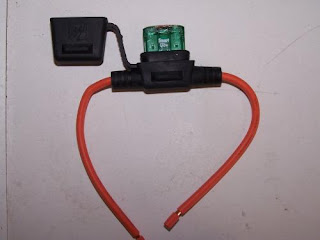The topic of batteries for portable radio operations and SOTA (Summits On The Air) often comes up on the various forums and email reflectors. When I first began operating portable with my FT-817ND in 2009, I used SLA (Sealed Lead Acid) batteries to power the radio. These batteries are often found in emergency exit lighting systems, uninterrupted power supplies, motorcycles, kids scooters, etc. They have their place, but they are large, very heavy, and voltage output drops considerably under load. The advantages are they are relatively easy to come by, don't require any special safety concerns, and require a very simple trickle charger to charge them. In the end, I just couldn't get past their size and weight. If I was taking my radio on any sort of long hike, I didn't want an extra 3 pound chunk of lead in my backpack.
I decided to take the time and educate myself on other batteries available, and ultimately decided to use a Lithium Polymer (LiPo) battery made for remote control hobby applications. These batteries pack a lot of capacity and voltage into a small, light package. They work well in cold weather, and have a relatively flat voltage discharge curve. They do come with their own set of rules, however, and it's wise to do your research lest you unwittingly burn your house down. With care though, they are an excellent tool for portable electronic applications.
I'll give you a quick overview here:
The nominal voltage of a single cell LiPo battery is 3.7 volts, and they are usually put into multi cell packs to achieve the desired voltage. When you shop for these batteries they are labeled by cell number with an "S". 1S = 1 cell (3.7v), 2S = 2 cells (7.4v), 3S = 3 cells (11.1v), and so on. The next number is usually their capacity (750mah, 2200mah, etc.) The third number to pay attention to is the "C" number. This number is the maximum amount of current you can draw from the battery in relation to the capacity (C*Capacity = Max current draw).Common "C" values are 25C, 35C, etc. Suppose you have a 3S 2200mah 25C battery - this means the battery will provide 11.1 volts @ 55 amps. That is a lot of power! Usually the higher the C value, the more expensive the battery. Even using a 100 watt radio you're not even going to come close to the common 25C rating, so go ahead and get a battery with a lower C rating and save yourself some money.
Now lets compare the specs:
5ah SLA battery: $15 from Amazon. 39 cubic inches. 56 ounces.
5ah LiPo battery: $23 from HobbyKing. 28 cubic inches. 14 ounces.
Anyone looking to reduce the size and weight of their system should appreciate those numbers!
"Well, I can buy 3 SLA batteries for the price of 2 LiPo batteries" you contend. True, but let's take a look at the usable life of each battery. SLA batteries are usually only rated for 200-300 discharge cycles. A properly cared for LiPo can theoretically be discharged anywhere from 500-1000 times. That's a lot! Depending on how you use the LiPo during that time can lead to much shorter or longer lifespans, but the point is they typically last much longer than SLA's.
If LiPo's are so great why isn't everyone using them? Because if they are mistreated they can easily catch on fire! If you accidentally puncture a cell, it usually leads to a fire. If you short circuit the battery it dumps a lot of current very quickly, creating a lot of heat, which melts the cells, and usually leads to a fire. If you charge the battery too quickly or discharge the battery too much, it creates heat, and can cause the battery to catch on fire. With a little care though fire can be avoided! Store them in a fireproof container, use a LiPo Safe bag when charging, don't throw them/excessively drop them, don't leave them charging unattended, etc. as long as you follow these rules, you should never run into any problems.
Many people prefer LiFePo4 batteries because they exhibit a lot of similar qualities as a LiPo, but are typically much safer. While they don't like being discharged too much or being punctured, just like the LiPo, the odds of them catching on fire are very slim. They have a nominal voltage of 3.2 volts, which makes for a convenient 12.8v 4S pack. The reason I did not go this route is these batteries are a lot more expensive, and are a tad bit larger and heavier than LiPo's given the same capacity. For example a 4S 4200mah 30C LiFePo4 will run you $41 from HobbyKing, 44 cubic inches, 19 ounces.
Whatever battery you decide on, make sure that your radio will handle the voltage. While a 4S LiPo has a nominal voltage of 14.8 volts, when fully charged they can sit around 16.8 volts, which is typically too high for your average radio. For the FT-817 a 3S LiPo @ 12.6v charged, 9.9v discharged is just about perfect. Other radios aren't happy under 11 volts, so a 4S LiPo with a voltage regulator might be an option.
LiPo batteries come with a variety of connectors, but I always cut them off and install Anderson Power Poles so all my electronics gear is interchangeable. Just be careful not to short the wires if you do decide to cut off the connector and install something different, because short circuiting these batteries can cause fires! Most sources agree that LiPo's should not be discharged below 3.3v per cell, so I use a small voltage alarm plugged into the balance leads of the battery to ensure I don't accidentally over discharge my battery. For $3 they are cheap insurance!




